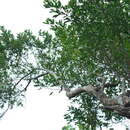pt-BR
nomes no trilho de navegação


Zanthoxylum dimorphophyllum (Chinese: 异叶花椒) is a tree from the family Rutaceae.[1][2]
Zanthoxylum dimorphophyllum is a deciduous tree that is typically 10 metres (33 ft) tall.[1] It is primarily found in moist areas within thickets, upland forests, and hillside open forests, including, but not limited to, in the countries of Thailand, China, and Vietnam.[1] Its branches are unarmed or with minimal prickles, and are grayish black in color at maturity, with rust-colored young branchlets and shoots.[1] Its fruit follicles are purplish red, 6-8 millimeters in diameter and sparsely pubescent when young, with sparse oil glands, stipitate, and shortly beaked apex.[1] The leaves contain have been recorded as having 28 mg/g of leaf nitrogen per dry mass.[2] Male flowers have 4-6 stamens while female flowers have 4-5 staminodes.[1]
The species was recorded as a species in Oxford's Annals of Botany in 1895. [3] It would later be accepted as a species in 2003's Danh lục các loài thực vật Việt Nam and 2008's Flora of China.[4]
There are three published varieties, including Zanthoxylum dimorphophyllum var. dimorphophyllum which has been found with a margin of leaflet blades with spines, Zanthoxylum dimorphophyllum var. multifoliolatum (C. C. Huang) which has been found with 3 to 5 leaflets, and Zanthoxylum dimorphophyllum var. spinifolium (Rehder & E. H. Wilson) which has been found with 7 to 11 leaflets.[1] In 1997, C. C. Huang mistakenly classified Zanthoxylum dimorphophyllum as a synonym for Z. ovalifolium Wight, which is found from India to Northeast Australia, not in the same East and Southeast Asian forests that Zanthoxylum dimorphophyllum appears.[1] This classification is still found in some records.[5] Fagara dimorphophylla has previously been recorded as a possible synonym,[4] which itself was identified in 1896 though later published as "not accepted" in 2001 World Checklist of Seed Plants Database.[6]
A 2001 study on the compounds of Zanthoxylum dimorphophyllum var spinifolium, isolated five compounds including the new 6-(2',3'-dihydroxy-3'-methybutyl)-7-acetoxy-2H-1-benzopyran-2-one.[7] A 2020 study hoping to identify compounds for the purpose of pest control isolated two new coumarins from Zanthoxylum dimorphophyllum var spinifolium.[8]